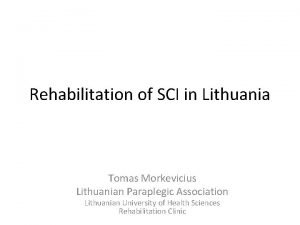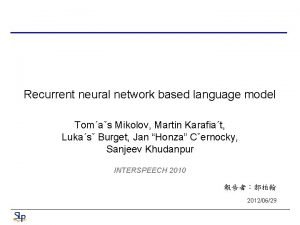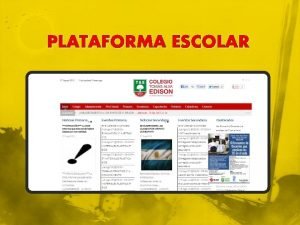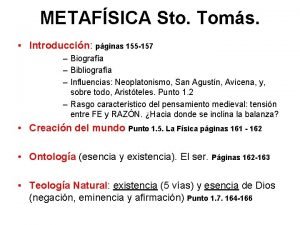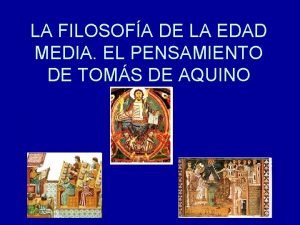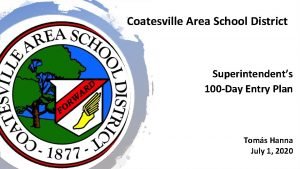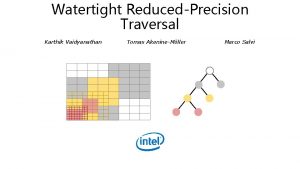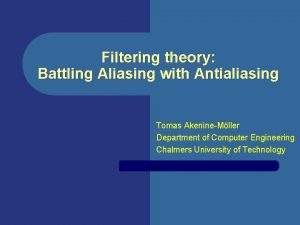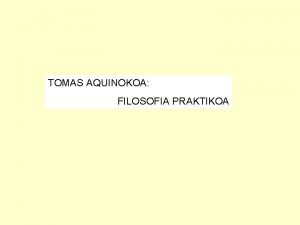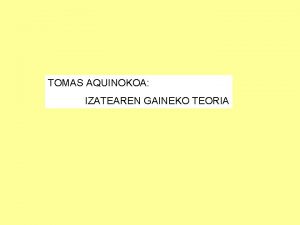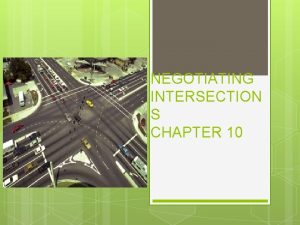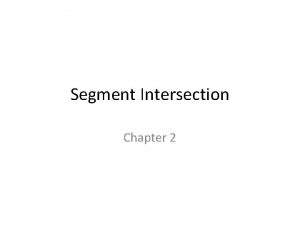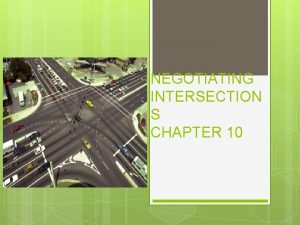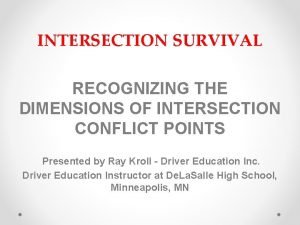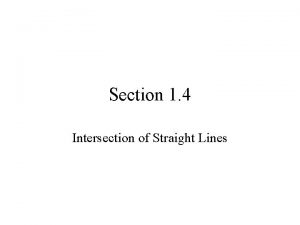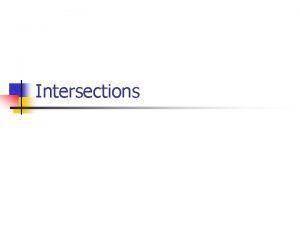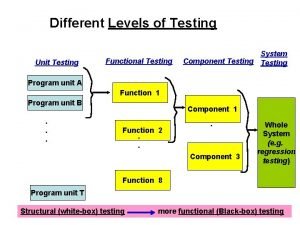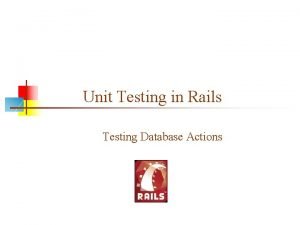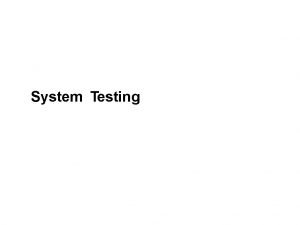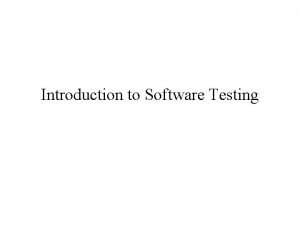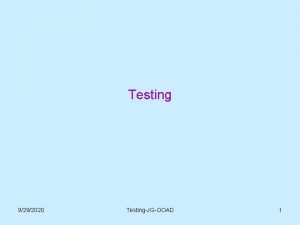Intersection Testing Chapter 13 Tomas AkenineMller Department of























![Dynamic Intersection Testing [In book: 620 -628] Testing is often done every rendered frame, Dynamic Intersection Testing [In book: 620 -628] Testing is often done every rendered frame,](https://slidetodoc.com/presentation_image_h/2f0decad4f039179c37f3f189f26b60c/image-24.jpg)


- Slides: 26

Intersection Testing Chapter 13 Tomas Akenine-Möller Department of Computer Engineering Chalmers University of Technology

What for? l l A tool needed for the graphics people all the time… Very important components: – l Finding if (and where) a ray hits an object – – l l Need to make them fast! Picking Ray tracing and global illumination For speed-up techniques Collision detection (treated in a later lecture) Tomas Akenine-Mőller © 2003

Some basic geometrical primitives Ray: l Sphere: l Box l – – l Axis-aligned (AABB) Oriented (OBB) k-DOP Tomas Akenine-Mőller © 2003

Four different techniques Analytical l Geometrical l Separating axis theorem (SAT) l Dynamic tests l l Given these, one can derive many tests quite easily – However, often tricks are needed to make them fast Tomas Akenine-Mőller © 2003

Analytical: Ray/sphere test d Sphere center: c, and radius r l Ray: r(t)=o+td l Sphere formula: ||p-c||=r l Replace p by r(t), and square it: l o r c Tomas Akenine-Mőller © 2003

Analytical, continued l o Be a little smart… d c Such tests are called ”rejection tests” l Other shapes: l Tomas Akenine-Mőller © 2003

Geometrical: Ray/Box Intersection Boxes and spheres often used as bounding volumes l A slab is the volume between two parallell planes: l l A box is the logical intersection of three slabs (2 in 2 D): BOX Tomas Akenine-Mőller © 2003

Geometrical: Ray/Box Intersection (2) l Intersect the 2 planes of each slab with the ray Keep max of tmin and min of tmax If tmin < tmax then we got an intersection l Special case when ray parallell to slab l l Tomas Akenine-Mőller © 2003

Separating Axis Theorem (SAT) Page 563 in book l Two convex polyhedrons, A and B, are disjoint if any of the following axes separate the objects: – – – An axis orthogonal to a face of A An axis orthogonal to a face of B An axis formed from the cross product of one edge from each of A and B axis A and B overlaps on this axis Tomas Akenine-Mőller © 2003

SAT example: Triangle/Box is axis-aligned l 1) test the axes that are orthogonal to the faces of the box l That is, x, y, and z l Tomas Akenine-Mőller © 2003

Triangle/Box with SAT (2) Assume that they overlapped on x, y, z l Must continue testing l 2) Axis orthogonal to face of triangle l axis Triangle seen from side Tomas Akenine-Mőller © 2003

Triangle/Box with SAT (3) If still no separating axis has been found… l 3) Test axis: t=ebox x etriangle l Example: l – – x-axis from box: ebox=(1, 0, 0) etriangle=v 1 -v 0 Test all such combinations l If there is at least one separating axis, then the objects do not collide l Else they do overlap l Tomas Akenine-Mőller © 2003

Rules of Thumb for Intersection Testing l Acceptance and rejection test – Try them early on to make a fast exit Postpone expensive calculations if possible l Use dimension reduction l – E. g. 3 one-dimensional tests instead of one complex 3 D test, or 2 D instead of 3 D Share computations between objects if possible l Timing!!! l Tomas Akenine-Mőller © 2003

Another analytical example: Ray/Triangle in detail v 2 Ray: r(t)=o+td v 1 l Triangle vertices: v 0, v 1, v 2 -v 0 v 1 -v 0 l A point in the triangle: v 0 =(1 l t(u, v)=v 0+u(v 1 - v 0 ) +v(v 2 - v 0 )= -u-v)v 0+uv 1+vv 2 [u, v>=0, u+v<=1] l Set t(u, v)=r(t), and solve! l Tomas Akenine-Mőller © 2003

Ray/Triangle (2) l Solve with Cramer’s rule: l Share factors to speed up computations Tomas Akenine-Mőller © 2003

Ray/Triangle (3) Implementation l Be smart! – Compute as little as possible then test l Examples: l Compute Then test valid bounds l if (v<0 or v>1) exit; l Tomas Akenine-Mőller © 2003

Point/Plane l Insert a point x into plane equation: Negative half space Positive half space origin Tomas Akenine-Mőller © 2003

Sphere/Plane AABB/Plane Sphere: compute l f (c) is the signed distance (n normalized) l abs( f (c)) > r no collision l abs( f (c)) = r sphere touches the plane l abs( f (c)) < r sphere intersects plane l Box: insert all 8 corners l If all f ’s have the same sign, then all points are on the same side, and no collision Tomas Akenine-Mőller © 2003 l

AABB/plane The smart way (shown in 2 D) l Find diagonal that is most closely aligned with plane normal l Need only test the red points More details in book Tomas Akenine-Mőller © 2003

Ray/Polygon: very briefly Intersect ray with polygon plane l Project from 3 D to 2 D l How? l Find max(|nx|, |ny|, |nz|) l Skip that coordinate! l Then, count crossing in 2 D l Tomas Akenine-Mőller © 2003

Volume/Volume tests Used in collision detection l Sphere/sphere l – l Axis-Aligned Bounding Box/AABB – l l Compute squared distance between sphere centers, and compare to (r 1+r 2)2 Test in 1 D for x, y, and z Oriented Bounding boxes Use SAT [details in book] Tomas Akenine-Mőller © 2003

View frustum testing l l l View frustum is 6 planes: Near, far, right, left, top, bottom Create planes from projection matrix – – l Sphere/frustum common approach: – – l Let all positive half spaces be outside frustum Not dealt with here -- p. 613 -614 Test sphere against 6 frustum planes If in positive half space and r distances from plane => no intersection If intersecting plane or in negative half space, continue If not outside after all six planes, then inside or intersecting Example follows… Tomas Akenine-Mőller © 2003

View frustum testing example outside frustum intersecting frustum l Not exact test, but not incorrect – – l A sphere that is reported to be inside, can be outside Not vice versa Similarly for boxes Tomas Akenine-Mőller © 2003
![Dynamic Intersection Testing In book 620 628 Testing is often done every rendered frame Dynamic Intersection Testing [In book: 620 -628] Testing is often done every rendered frame,](https://slidetodoc.com/presentation_image_h/2f0decad4f039179c37f3f189f26b60c/image-24.jpg)
Dynamic Intersection Testing [In book: 620 -628] Testing is often done every rendered frame, i. e. , at discrete time intervals l Therefore, you can get ”quantum effects” l Frame n+1 Dynamic testing deals with this l Is more expensive l Deals with a time interval: time between two frames Tomas Akenine-Mőller © 2003 l

Dynamic intersection testing Sphere/Plane t=n r c sc l sc & se are signed distances v n r No collision occur: – – se e t=n+1 If they are on the same side of the plane (scse>0) Plus |sc|>r and |se|>r Otherwise, sphere can move |sc|-r l Time of collision: l Response: reflect v around n, and move (1 -tcd)r Tomas Akenine-Mőller © 2003 l

Dynamic Separating Axis Theorem l SAT: tests one axis at a time for overlap l Same with DSAT, but: – Need to adjust the projection on the axis so that the interval moves on the axis as well Need to test same axes as with SAT l Same criteria for overlap/disjoint: l – – If no overlap on axis => disjoint If overlap on all axes => objects overlap Tomas Akenine-Mőller © 2003
 Domain closure in software testing
Domain closure in software testing Logic based testing
Logic based testing Du path testing
Du path testing Positive vs negative testing
Positive vs negative testing Cs3250
Cs3250 Globalization testing example
Globalization testing example Neighborhood integration testing
Neighborhood integration testing Cause effect graph for triangle problem
Cause effect graph for triangle problem Control structure testing in software engineering
Control structure testing in software engineering Decision table testing in software testing
Decision table testing in software testing Decision table advantages and disadvantages
Decision table advantages and disadvantages Jelaskan pengertian pengujian black box
Jelaskan pengertian pengujian black box Black-box testing disebut juga sebagai behavioral testing
Black-box testing disebut juga sebagai behavioral testing Decision table based testing in software testing
Decision table based testing in software testing Rigorous testing in software testing
Rigorous testing in software testing Testing blindness in software testing
Testing blindness in software testing Component testing is a black box testing
Component testing is a black box testing Domain testing example
Domain testing example Tomas kemeny
Tomas kemeny Tomas kohout
Tomas kohout Tomas morkevicius
Tomas morkevicius Tomas mikolov
Tomas mikolov Educamos tomas alva edison
Educamos tomas alva edison Vias de tomas de aquino
Vias de tomas de aquino 5 vias de santo tomas de aquino
5 vias de santo tomas de aquino Tomas bujnak
Tomas bujnak Coatesville area school district
Coatesville area school district




















